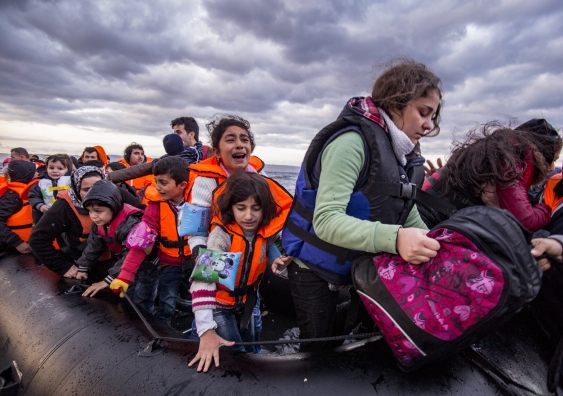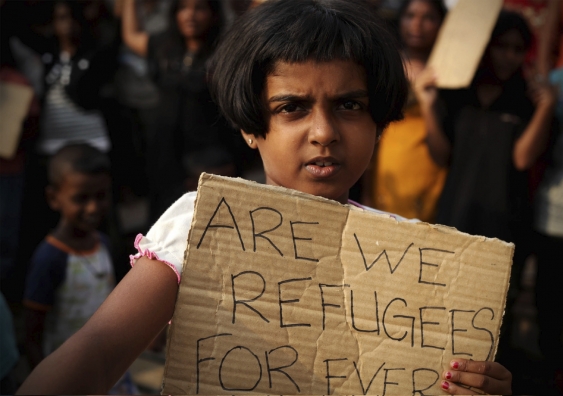Defending the Refugee Convention
The building blocks for effective responses to people on the move already exist – states must simply choose to use them, argues Jane McAdam.
The building blocks for effective responses to people on the move already exist – states must simply choose to use them, argues Jane McAdam.

OPINION: It is 65 years since the Refugee Convention was adopted. This year, there are 65 million displaced people in the world. The synchronicity of those figures would have caused the drafters of the convention grave concern. The Refugee Convention was intended to provide a consistent and predictable means of granting refugees a legal status, and thus a means of finding a durable solution, whether through local integration, resettlement or voluntary repatriation.
Some critics say the 1951 Refugee Convention has passed its use-by date. It is, we are told, too old to respond adequately to the displacement challenges of the 21st century, whether because it is too restrictive in its reach or too generous. It is at once too narrow and too broad; simultaneously blocking access and facilitating it.
These are unfair criticisms, and largely miss the point. The convention needs the political will of governments – which is often lacking –to function properly. At the same time, it was never intended to be a migration-management tool, nor a responsibility-sharing mechanism.
The Refugee Convention was never a revolutionary instrument; largely, it consolidated existing refugee agreements. It certainly does not provide a “blank cheque” for refugees. What it does do is articulate fundamental rights and duties owed to, and by, refugees, which in some respects have been bolstered and extended by international human rights law. Renouncing the Refugee Convention would not undo these obligations.
The Refugee Convention was drafted after World War II had displaced more than 50 million people in Europe. The number of refugees in Germany alone was 14 million. The convention was one of a number of foundational human rights instruments negotiated at the time – including the Universal Declaration of Human Rights, the twin human rights covenants and the Genocide Convention – when the atrocities of the war still loomed large, and the refrain “never again” was front of mind.
At that time, the “ideal” of refugee resettlement – a mechanism viewed both as a solution for Jewish refugees, and as a more general population-management tool in the face of resource scarcity – had proved impossible, which was why the creation of a legal status to be enjoyed within host states was seen as very important. A formal international agreement was a way to ensure signatory states offered similar levels of protection.

Photo Credit: Ulet Ifansasti/Getty Images
Some rights set out in the convention apply as soon as an asylum seeker arrives in a country, including the right not to be returned to persecution (the principle of non-refoulement), the right not to be discriminated against, freedom of religion, access to courts and to elementary education, and the right not to be penalised for illegal entry (recognising that people fleeing persecution may not be able to acquire visas or the like). It’s instructive to note that international laws on human trafficking and smuggling make clear that refugee law is paramount here.
Other rights accrue once a refugee is lawfully admitted to a country, such as access to employment, social security and so on. On the question of how extensive such rights should be, the convention provides that, at a minimum, refugees must receive the same standard of treatment as other foreigners in the country. Some rights – such as access to the courts and legal assistance, elementary education, social security, public relief and assistance and the right to practise one’s religion – must be accorded at the same level as citizens.
Under the Refugee Convention, refugees also have responsibilities: they must abide by the law and any measures in force for the maintenance of public order in the country that grants them protection.
The convention does not envisage refugee status as permanent, but that’s different from saying that protection need only be temporary. The idea is that refugees transition to a durable solution through voluntary repatriation (if the circumstances in the country of origin have changed fundamentally), local integration or resettlement – with the latter two assumed to give rise to naturalisation at some point. Indeed, the Refugee Convention says countries should facilitate the assimilation and naturalisation of refugees. This helps refugees to build a new life in safety, security and dignity. In fact, refugees granted citizenship are more likely to return home to rebuild the country once conflict has ended, because citizenship provides them with a safety net if things don’t work out. Naturalisation is also bureaucratically efficient. Imagine the burden of having to constantly reassess whether or not a person still meets the refugee definition over time. It would be like painting the Sydney Harbour Bridge: you no sooner reach the end than you have to start all over again.
The Refugee Convention’s definition of a “refugee” has been subject to dynamic interpretation over the past 65 years. For instance, while the drafters never envisaged gender-based persecution as a ground for refugee status, the rules of treaty interpretation have allowed the convention to adapt to evolving conceptions of human rights law.
Its scope is not unlimited. The convention contains strictly defined exclusion clauses to prevent people who have committed very serious crimes, including genocide, torture, murder and terrorism, from obtaining refugee status. The rationale was that countries should not shelter fugitives from justice by granting them asylum. Furthermore, it was thought that perpetrators of serious crimes, such as former Nazis, should not be protected alongside the people they had persecuted.
The drafters of the convention were well aware that refugee protection was not a way to short-circuit migration controls – on the contrary, refugee status determination demands the most stringent checks of all.
So, when considering some of the objections levelled at the Refugee Convention today, we need to be cautious about misdiagnosis. It was never intended as a comprehensive document; it did not deal directly with large-scale refugee movements, details of international co-operation or shared solutions.
What factors, then, are behind the messiness we see today? Foremost is a lack of political will to tackle the challenges head-on and accept responsibilities, especially in view of the largest displacement numbers we have seen since World War II.
Second, there is a failure to take the forecasting seriously and to plan. Syria did not happen overnight: the writing was on the wall for a good five years before refugees began leaving for Europe, and the lessons of history were there to see … if only one cared to look.
Third, there is a woeful lack of humanitarian funding. The UN’s Syria appeal is its largest ever, yet it remains terribly underfunded. In September 2015, the World Food Program was forced to cut food aid to 229,000 Syrian refugees in Jordan because it ran out of money. As a Norwegian Refugee Council representative noted: “Refugees mention to us cuts in food assistance as one of the main reasons for leaving Jordan” and moving on to Europe. While conflict may be the initial driver, the failure to address humanitarian needs in countries of first asylum adds to people’s desperation and search for safety.
We must use the building blocks for effective responses that already exist in international law. This includes the Refugee Convention, an instrument motivated by our shared commitment that never again should the world bear witness to millions of people fleeing for safety and being turned away.
It’s also about resourcing front-line countries to better support and integrate refugees where possible. Refugees now comprise about 25 per cent of Lebanon’s population. Refugees are not on a world tour – most prefer to stay close to home if they can, just as the majority did for the first five years of the Syrian conflict. This kind of assistance should be pursued as both a humanitarian and development strategy, not as a containment strategy.
Fourth, as a former assistant high commissioner for refugees, Erika Feller, said: “There are many asylum systems which remain ineffective or unresponsive, with some purposefully in decline, perhaps aimed at serving a deterrent function.” Rather than using the Refugee Convention as a blueprint to guide positive action, some states look for the grey areas to confine and restrict their obligations as far as arguably possible.
There has always been a “responsibility deficit” in the refugee protection regime. When the Refugee Convention was drafted back in 1950, states rejected a proposal by the then UN secretary-general to formally co-operate by “agreeing to receive a certain number of refugees in their territory”, and for this reason the treaty does not settle the distribution of refugees. Events in Europe over the past two years have shown the precariousness of protection when states fail to co-operate.
Where to from here?
Jane McAdam is Scientia Professor of Law, Director of the Kaldor Centre for International Refugee Law, and head of the Grand Challenge on Refugees & Migrants at UNSW.
This is an edited transcript of a speech given at the Kaldor Centre annual conference on 18 November. The article was first published in the print edition of The Saturday Paper. Read the entire piece online.